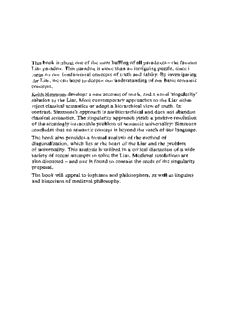
Universality and the Liar: An Essay on Truth and the Diagonal Argument PDF
Preview Universality and the Liar: An Essay on Truth and the Diagonal Argument
This book is about one of the most baffling of all paradoxes - the famous Liar paradox. This paradox is more than an intriguing puzzle, since it turns on our fundamental concepts of truth and falsity. By investigating the Liar, we can hope to deepen our understanding of our basic semantic concepts. Keith Simmons develops a new account of truth, and a novel 'singularity' solution to the Liar. Most contemporary approaches to the Liar either reject classical semantics or adopt a hierarchical view of truth. In contrast, Simmons's approach is antihierarchical and does not abandon classical semantics. The singularity approach yields a positive resolution of the seemingly intractable problem of semantic universality: Simmons concludes that no semantic concept is beyond the reach of our language. The book also provides a formal analysis of the method of diagonalization, which lies at the heart of the Liar and the problem of universality. This analysis is utilized in a critical discussion of a wide variety of recent attempts to solve the Liar. Medieval resolutions are also discussed - and one is found to contain the seeds of the singularity proposal. The book will appeal to logicians and philosophers, as well as linguists and historians of medieval philosophy. Universality and the Liar Universality and the Liar An essay on truth and the diagonal argument KEITH SIMMONS UNIVERSITY OF NORTH CAROLINA, CHAPEL HILL CAMBRIDGE UNIVERSITY PRESS Published by the Press Syndicate of the University of Cambridge The Pitt Building, Trumpington Street, Cambridge CB2 IRP 40 West 20th Street, New York, NY 10011-4211, USA 10 Stamford Road, Oakleigh, Melbourne 3166, Australia © Cambridge University Press 1993 First published 1993 Library of Congress Cataloging-in-Publication Data Simmons, Keith. Universality and the Liar : an essay on truth and the diagonal argument / Keith Simmons. p. cm. Includes bibliographical references. ISBN 0-521-43069-0 (he) 1. Liar paradox. 2. Universals (Philosophy) I. Title. BC199.2.S56 1993 i65~dc20 92-28986 CIP A catalog record for this book is available from the British Library. ISBN 0-521-43069-0 hardback Transferred to digital printing 2004 To my parents Amy Simmons and Stanley Simmons with love and gratitude Contents Preface page ix Chapter 1 The Liar paradox 1 1.1 Some versions of the Liar 2 1.2 Proposals 7 1.3 Universality and semantic universality 13 1.4 Diagonalization 16 Chapter 2 The diagonal argument 20 2.1 Cantor's use of the diagonal argument 20 2.2 General analysis of the diagonal argument 22 2.3 Good and bad diagonal arguments 27 Appendix Extensions of the diagonal theorem 37 Chapter 3 The diagonal argument and the Liar, I 45 3.1 A problem for truth gap theories 46 3.2 Kripke's theory of truth 47 3.3 Fuzzy logic 55 3.4 A thesis of expressive incompleteness 58 Chapter 4 The diagonal argument and the Liar, II 62 4.1 Herzberger and Gupta and stable truth 62 4.2 Feferman: A type-free theory of partial predicates 70 4.3 McGee and definite truth 72 4.4 Inconsistency views 78 Chapter 5 A medieval solution to the Liar 83 5.1 An outline of the Ockham-Burley-Pseudo-Sherwood solution 84 5.2 An interpretation of the Ockham-Burley- Pseudo-Sherwood solution 86 vn Contents 5.3 Comparisons and contrasts with some modern approaches 94 Chapter 6 A singularity solution to the Liar 99 6.1 An informal presentation of the singularity solution 100 6.2 A glimpse of the formal account 112 6.3 A suggestion of GodePs 116 Chapter 7 A formal account of singularities 118 7.1 Pragmatic and semantic aspects 118 7.2 The reflective hierarchy and singularities 121 7.3 English and the reflective hierarchy 139 Chapter 8 Applications and further singularities 142 8.1 Applications of the formal account 142 8.2 Further singularities 153 Chapter 9 Semantic universality 159 9.1 Groundedness (and "singularity" in one sense) 159 9.2 Truth in a context (and "singularity" in a second sense) 163 9.3 The object language and the language of the theory 174 9.4 Universality 181 Notes 183 Bibliography 217 Index 225 vin
Description: